|
|
|
|
|
|
In response to the Railway Clearing House joint sub-committees' recommendation of June 1929, banner type subsidiary signals were being provided in certain areas of the LNER in connection with colour light signalling. The banner arm was horizontally striped in the same manner as the new standard subsidiary semaphore arm, and the appropriate letter "C", "S" or "W" was printed in red on the face of the signal [4.82 - 4.87].
 |
 |
|
[4.82] Banner Type Calling-on Signal ('on').
Area: LNER Usage: Unknown Status: Historical |
[4.83] Banner Type Calling-on Signal ('off').
Area: LNER Usage: Unknown Status: Historical |
|---|---|
 |
 |
|
[4.84] Banner Type Shunt-ahead Signal ('on').
Area: LNER Usage: Unknown Status: Historical |
[4.85] Banner Type Shunt-ahead Signal ('off').
Area: LNER Usage: Unknown Status: Historical |
 |
 |
|
[4.86] Banner Type Warning Signal ('on').
Area: LNER Usage: Unknown Status: Historical |
[4.87] Banner Type Warning Signal ('off').
Area: LNER Usage: Unknown Status: Historical |
In the Great Western Railway's early colour light signalling schemes (e.g. Cardiff East, May 1933), subsidiary signals took the form of an 'opal plate', normally extinguished. When illuminated, the indicator displayed an image of a semaphore subsidiary arm in the 'off' position, along with the appropriate letter "C", "S" or "W" [4.88 - 4.90].
 |
 |
 |
|
[4.88] Calling-on Signal ('off').
Area: GWR Usage: Medium Status: Historical |
[4.89] Shunt-ahead Signal ('off').
Area: GWR Usage: Medium Status: Historical |
[4.90] Warning Signal ('off').
Area: GWR Usage: Medium Status: Historical |
|---|
The Railway Clearing House sub-committee recommended in June 1934 that, for the sake of uniformity, subsidiary signals in colour light signalling areas should be of the same form as the shunting signals (see Section 3) at the same location. If the signal controlled entry into the block section, a distinguishing letter "C" or "S" would be required. The sub-committee also proposed that warning acceptance at colour light signals be given not by a subsidiary signal but by the main aspect, possibly to be accompanied by a letter "W".
|
When the Cheshire Lines Committee's Manchester Central terminus was resignalled with colour light signals in June 1935, the calling-on signals took the form of a small yellow aspect, with a letter "C" below [4.91]. No indication was given when the calling-on signal was 'on'. |
|
Later colour light signalling schemes on the Great Western Railway (e.g. Bristol East, November 1935) discontinued the use of 'opal plates' (see [4.88 - 4.90]) in favour of subsidiary signals comprising a small green aspect, normally extinguished. When cleared, a small green light was displayed together with the appropriate illuminated letter "C", "S" or "W" [4.92 - 4.94].
 |
 |
 |
|
[4.92] Calling-on Signal ('off').
Area: GWR Usage: Medium Status: Historical |
[4.93] Shunt-ahead Signal ('off').
Area: GWR Usage: Medium Status: Historical |
[4.94] Warning Signal ('off').
Area: GWR Usage: Medium Status: Historical |
|---|
The Railway Clearing House sub-committee's recommendations of June 1934 concerning subsidiary signals in colour light signalling areas were accepted by the Ministry of Transport on 11 March 1936. Consequently, the provision of banner type subsidiary signals with horizontally striped arms (see [4.82 - 4.87]) was discontinued in future schemes.
Around 1937, the Southern Railway introduced a calling-on signal for use in colour light signalling areas, in the form of a disc with a plain red band superimposed on a black letter "C" [4.95 & 4.96]. The disc was illuminated at night.
 |
 |
|
[4.95] Disc Type Calling-on Signal ('on').
Area: Southern Railway Usage: High Status: Historical |
[4.96] Disc Type Calling-on Signal ('off').
Area: Southern Railway Usage: High Status: Historical |
|---|
'Draw-ahead' signals were first mentioned in a July 1937 supplement to the Rule Book. When cleared, they authorised the driver to proceed towards the next stop signal but not to pass any shunting signal that may be at 'danger'. A draw-ahead signal in semaphore form was cleared to the 'off' position without any distinguishing letter being displayed [4.97 & 4.98]. A draw-ahead signal was never provided at a signal that controlled the entrance to the block section ahead. The provision of draw-ahead signals was discontinued in 1950, and those previously installed were replaced by calling-on signals.
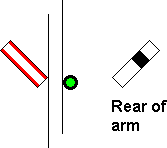 |
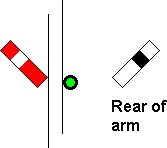 |
|
[4.97] Draw-ahead Signal ('off').
Area: Various Usage: Unknown Status: Historical |
[4.98] Draw-ahead Signal ('off').
Area: Various Usage: Unknown Status: Historical |
|---|
Around 1941, some of the banner type subsidiary signals on the LNER (see [4.82 - 4.87]) were altered to be unlit when in the 'on' position.
In areas where position light shunting signals were present, subsidiary signals were of the normally unlit position light type. When cleared, these displayed two white lights inclined at 45°, later accompanied by the appropriate distinguishing letter "C", "S" or "W" [4.99 - 4.101]. In 1950, it was decided that the distinguishing letter "C" would be incorporated in the lower of the two white lights in position light type calling-on signals [4.102], but this decision was soon reversed. The practice of providing position light type subsidiary signals with the distinguishing letters "C", "S" and "W" was discontinued in 1960, and existing signals of this type ceased to display them from 1983.
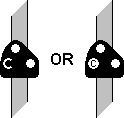 |
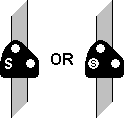 |
|
[4.99] Position Light Calling-on Signal ('off').
Area: All Areas Usage: High Status: Obsolescent |
[4.100] Position Light Shunt-ahead Signal ('off').
Area: All Areas Usage: Medium Status: Historical |
|---|---|
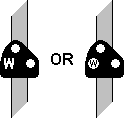 |
 |
|
[4.101] Position Light Warning Signal ('off').
Area: All Areas Usage: Medium Status: Historical |
[4.102] Position Light Calling-on Signal ('off').
Area: All Areas Usage: Unknown Status: Historical |
|
A single calling-on arm could apply to more than one route from a main semaphore signal. On the Southern Region, the calling-on arm in this instance was accompanied by an indicator that displayed a numeral in addition to the usual letter "C" when the arm was in the "off" position [4.103]. The numeral identified the route for which the signal was cleared, "1" referring to the route on the extreme left, and "2" referring to the second route from the left. |
|
|
|